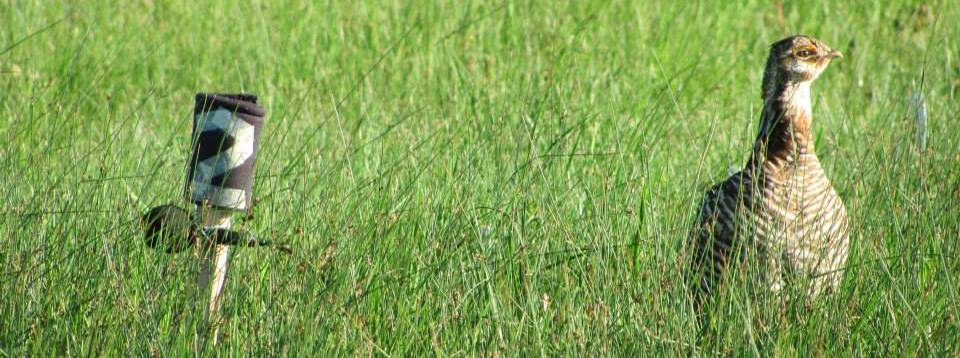Concerns about the potential indirect impacts of wind energy development and operation on prairie grouse from habitat fragmentation and the installation of tall vertical structures on the landscape, have prompted studies in Nebraska and beyond.

Research, Jennifer Smith, holding greater prairie chicken. Photo by Cara Whalen.

Greater prairie chicken with microphone used in research. Photo by Cara Whalen.
.jpg)
Ainsworth Wind Energy Facility. Photo by Caroline Jezierski.
Persistent Effects of Wind-power Development on Prairie Grouse in Nebraska
Overview
This research project was proposed by a team of research scientists at the University of Nebraska-Lincoln, University of Nebraska-Omaha, and Boys Town National Research hospital in response to a call for proposals in October 2011 from the Nebraska Game and Parks Commission.
The project's goal is to allow Nebraskans to optimize wind energy development in areas of concern for prairie grouse, while aiding investors, planners, and policy makers to identify ideal locations for future wind energy projects.
Specifically, the project aims to:
The research team will be collecting data that assesses avoidance of structures, predator distribution on the landscape, and the influence of turbine noise on prairie-chicken behavior.
The first year of data collection was in 2013. After the final year in 2014, final reports should be available in 2015.
Available Reports
- Whalen, C. 2015. Effects of Wind Turbine Noise on Male Greater Prairie-Chicken Vocalizations and Chorus. University of Nebraska - Lincoln, School of Natural Resources, M.S. Thesis.
- Harrison, J.O. 2015. Assessment of disturbance effects of an existing wind energy facility on greater prairie-chicken (Tympanuchus cupido pinnatus) breeding season ecology in the Sandhills of Nebraska. University of Nebraska - Lincoln, School of Natural Resources, M.S. Thesis.
- Wills, H.D. 2013. The relationship between wind turbines and corticosterone and testosterone levels in lekking male greater prairie chickens in Nebraska. University of Nebraska at Omaha, M.S. Thesis.
To learn more about the project, check out http://larkinpowell.wix.com/larkinpowell or contact Dr. Larkin Powell (lpowell3@unl.edu)
In the News
SNR researchers discover unusual prairie chicken movement
"We recently discovered that a hunter recovered a prairie chicken over 30 miles from its lek of capture," Olney said.University of Nebraska studying the effects of wind-power development on prairie chickens in Nebraska. Published March 2013, Ainsworth Star-Journal
The Grouse Girls head home after studying the Prairie chickens on the wind energy facility. Published on Wednesday, 31 July 2013, Ainsworth Star-Journal
Partners
Funding for this project was provided by the Nebraska Game and Parks Commission through the Wildlife Restoration Program.
This project is made possible with the cooperation of the Nebraska Public Power District and local landowners.



Grassland Community Collaborative
A subgroup of the National Wind Coordinating Collaborative, the Grassland Community Collaborative brings together stakeholders to address potential impacts of wind energy developments on grassland species and to identify and implement research critical to minimizing impacts.
Effects of Wind Power Development on the Population Biology of Greater Prairie-Chickens in Kansas
Seven years of research suggests that wind power does not strongly affect Greater Prairie-Chickens.
For more information: https://nationalwind.org/research/collaboratives/prairie-chicken/